An Incol 70/35 projection booth as found in an historical theater |
Read more at in70mm.com The 70mm Newsletter |
| Written by: Paulo Roberto P. Elias | Date: 01.04.2015 |
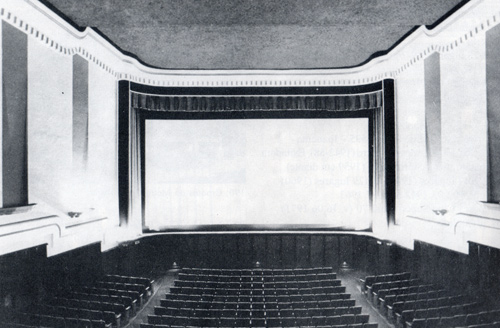 Cinema
Vitoria Cinema
VitoriaWhen the 70mm craze of the 1960’s was in progress a significant number of regular 35mm theaters refurbished their installations to give shelter to the relative more complex 70mm projection system. It took quite a long time but when the demise of the 70mm format exhibition started there was a coincidental decadence of the so-called street theaters and palace theaters that was due to the financial burden imposed by public administrators and service providers to major exhibitors and independent theater owners. One could list a number of highly expensive bills that took part in that demise. The Brazilian taxation system, for example, includes a fare for the territorial occupation of any building or even unoccupied land space, whose charges are made up to the discretion of public administrators. |
More in 70mm reading: Large Format in Brazil / 70mm In Rio Internet link: |
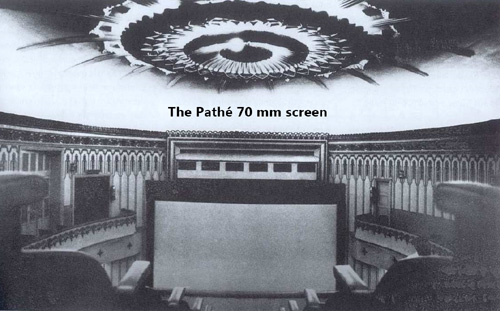 Cinema
Pathe Cinema
PatheThose charges are based on arbitrary alleged intrinsic values of the properties, and taxed without any sort of negotiation, unless the owner goes to court. That charge is locally known by the acronym IPTU. Some years ago, the mayor offered one of the main exhibitors to void the IPTU, in order to keep one of their large palaces open. Sometime later they charged the whole taxation, with interest rates included. What was supposedly a generous exemption to prevent the theater to end its operation ended up in an astronomical charge with no prior warning. The exhibitor paid in full and afterwards closed the theater permanently. |
|
 Cinema Pathé has most of its internal parts untouched. The projection booth is still fitted with the original Incol
70/35 projectors. Cinema Pathé has most of its internal parts untouched. The projection booth is still fitted with the original Incol
70/35 projectors.Click the image to see enlargement The IPTU disaster is added to the expected large electricity bill, cleaning and overall maintenance of the place. When patrons decreased in number, for a variety of reasons, the revenues in the box office decreased accordingly, to the point of becoming intolerable. In one attempt to preserve street theaters applications for having those places landmarked, or listed if you will, could be requested by any group of citizens who were interested in keeping those places untouched. Subsequently, a mayor’s decree would put the theater under protection and trust of the local preservation office. |
|
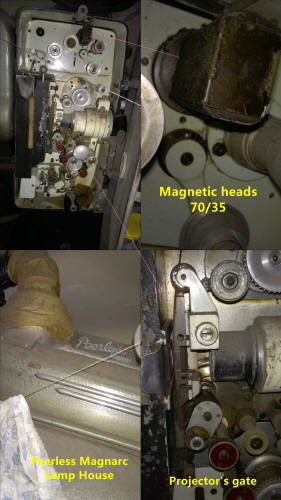 Close
up of the Incol 70/35 projector. Close
up of the Incol 70/35 projector.
Click the image to see enlargement However, land marking a theater did not prevent their owners to remove screens and seats, and from uninstalling the whole projection booth, including projectors and sound system. While a small amount of owners decided to just close down their venues other decided not to keep the financial burden for themselves, because land marking theaters does not exempt them for paying taxes and other bills. The solution they found was to rent the installations to third parties, which in turn would have to pay all the bills and taxes, whilst obeying the landmark rules for alteration or renovation. One notorious case of a landmarked theater with an unexpected end happened to the Cinema Vitória, the very first theater in Rio with 70mm projection. For a number of years the auditorium changed hands, one of these offered as a parking lot. If was finally purchased by a bookstore chain, which redecorated and preserved the original entrance hall and the auditorium walls. However, they removed the whole balcony and projection booth, acting accordingly to the landmark act. The original place of the screen (which was already removed anyway) is now occupied by one of their own set of book racks, and that alone will prevent visitors to have an idea how the Vitória was when it was still in operation. The picture below, showing the original 70mm screen, may give the visitor of the bookstore an idea of what is missing now. An historical theater, a much smaller venue, and located in the city centre, the Cinema Pathé has most of its internal parts untouched until now. The projection booth is still fitted with the original Incol 70/35 projectors, installed in the late 1960’s, albeit partially obstructed with maintenance products and with some components displaced or misplaced. An inspection of the more visible Incol 70/35 projector evidences that it may still be fully recovered for operation. The lamp house may or may not be fitted with Xenon lamps to that effect. The presence of oxidized parts seems to be restricted to the magnetic heads, but nothing impairs the installation of modern digital sound heads or scanners. |
|
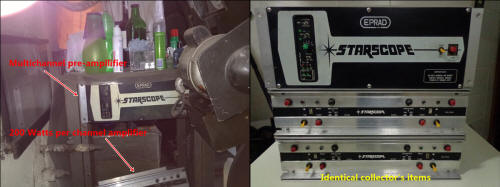 Sound
rack Sound
rackClick the image to see enlargement In the sound rack an Eprad multichannel preamplifier was found, and a lose 200/200 power amp was found just beneath. The pre-amp has room for two projectors, and according to the manufacturer it sports all sound playback level adjustments for both optical and magnetic tracks. Noise reduction is also included, that will prevent silver noise and hiss noise from optical and magnetic sound, respectively. The amplifiers are quoted as dual 200 Watts per channel, accepting a 4 ohms load from speakers. |
|
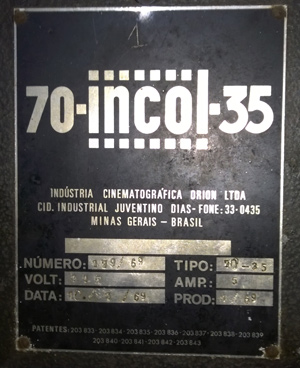 The
plaque in one of the projectors The
plaque in one of the projectorsThe plaque in one of the projectors marks the date when they were manufactured by Incol, namely 1969. This is most likely the year that the Pathé was refurbished to 70mm projection. The first feature that was exhibited was Ken Annakin’s “Those Magnificent Men In Their Flying Machines”, released in 1965, and shot in Todd-AO. The Cinema Pathé has an unique history of incredible background. The theater was initially established in 1907 in a different address in the city centre of Rio de Janeiro. At that the cinema was called “Cinematógrapho Pathé”. In 1915, the owners moved it to what was then called Avenida Central, number 143. The Avenida Central was afterwards changed to its current name “Avenida Rio Branco’, and the Pathé was then located at numbers 151/153 (later called “Cinelândia”). Up to September 1915, the Pathé was showing theatrical plays and films simultaneously. When the theater company left, the stage was kept intact, with the screen at the back. In 1928, the Pathé was once again completely remodelled with its current art déco walls and façade. The reform was conducted with the effort of its owner, the legendary photographer Marc Ferrez, who became notable for his pictures of the old Rio city landscapes. |
|
 Theatre
Fronts. Theatre
Fronts.Click the image to see enlargement There are still some remaining pictures with whom a limited but comprehensive time line could be established. When the theater was refurbished to 70mm projection the screen had to be installed in front of the old stage, moving away from the proscenium quite a bit. A rare picture of the auditorium will show the 70mm screen bordering the sides of the upper balcony. The Pathé is a small theater, it was never able to fill in a large number of patrons. Nevertheless the 70mm installation introduced to its audience a superb quality for projection and stereophonic sound, which only the 70mm gauge is able to provide. The Cinema Pathé closed down for film exhibition in 1999, lasted more in fact than most of the other theaters in the Cinelândia neighbourhood. The heydays of the 70mm screenings are long gone now in this town. In my opinion the preservation of projectors such as these should be carried on with the removal of all the equipment to a place where the original booth could be rebuilt for public visitation. They mark an important moment in the business, one that most young people of newer generations never had a chance to witness and enjoy. |
|
| Go: back - top - back issues - news index Updated 22-01-25 |
